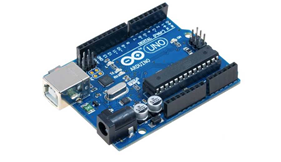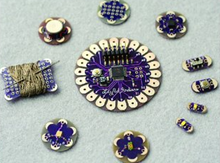IoT (Internet of Things) & Parylene Conformal Coatings
Posted by Sean Horn
Friday, November 27, 2020 8:00
@ 8:00 AM
The Internet of things (IoT) allows us to connect everyday things to the internet. It is defined as a network of devices, vehicles, appliances, and other things that are connected. IoT is possible with the use of sensors, actuators, electronics, and software embedded into the later. Data collected from these physical devices are sent back and forth for better operation through network connectivity. A multitude of applications in defense, security, medical and industrial applications are available. Wearable devices, underwater systems, agricultural technologies, smart home applications, automotive, aviation systems and other areas of applications make use of IoT devices.
Arduino and Lilypad are two examples of IoT hardware platforms that are actually printed circuit boards (PCB) and can combine a multitude of sensors, actuators and other IoT systems that can collect and process data.


Arduino Uno and Lilypad (for wearable IoT- photo courtesy of Leah Buechley)[1]
Role of sensors in the Internet of Things?
IoT devices contain sensors that can detect the position, acceleration, pressure, temperature, humidity, etc. Today, it is possible to design and manufacture IoT devices that are lightweight, multifunctional, reliable and efficient. One of the requirements for their reliability is their long term performance in various environments.
How to protect your IoT devices?
As explained above, vast amount of applications and the environments are possible therefore electronic parts, power systems and signals must be maintained and protected well from the environmental conditions. For Arduino, special plastic casings are available however, this does not allow for a compact and lightweight IoT device. Custom made PCB’s for different applications are also available from various manufacturers.
Parylene thin films offer pin-hole and stress free complete coverage. They can be used under almost any environmental condition provided that the right type of parylene is used (For more information about Parylene types and their properties you can visit: https://blog.paryleneconformalcoating.com/comparison-of-parylene-c-n-and-f-similarities-differences-and-their-application-areas).
Parylenes are all colorless and they are aesthetically pleasant. Their mechanical strength and high breakdown voltage make them attractive as protective coatings. They exhibit high dielectric strength which makes them favorable as insulators and the dielectric properties can be tuned by modifying their thickness. Parylene protective coatings can withstand cryogenic and relatively high temperatures (-400 °F (-200 °C) to +400 °F (+200 °C)) while maintaining their electrical and mechanical properties which is a rare property in materials systems. The combination of all these properties make them a great candidate for use as a protective coating in IoT applications.
Parylene C is the most widely used type among others (Parylene N, F). While they all find applications in microelectronics and PCB’s, Parylene C complies with the FDA regulations for biomedical use (ISO-10993 Biological Evaluations for Medical Applications microfluidic devices, medical implants (stents, needles, etc.) therefore Parylene C can be used in Medical IoT devices such as implants and wearable devices that contact with the skin for data collection (eg. Heartbeat, body temperature, sweat analysis, cochlear implants, etc.) [2].
Parylene F offers the lowest dielectric constant (2.17 @ 1 MHz) and it is a sought after conformal coating because it is not affected by the photo degradation, it has a very high thermal stability range. Parylene F exhibits a very high melting temperature (≤ 500 °C) compared to parylene N (420 °C) and C (290 °C).
Parylene N finds applications where constant dielectric coefficient at all frequencies is desired and it is relatively cheaper.
Flexible and lightweight sensors for IoT: Parylene as a conformal coating
Example of sensors and systems built on flexible Parylene layers are available in the literature and industry. Flexible and 8 μm thick micro temperature and humidity sensors on parylene thin films were reported by Chi-Yuan Lee et al as shown in the image below[3]. These flexible sensors offer light-weight and highly reliable systems to be used under compression. The sensitivities of temperature sensor was reported as 4.81 × 10−3 °C−1 and humidity 0.03 pF/%RH.

Flexible micro sensors on a parylene base Image Ref: [3].
Hong Lei et al reported the production of Ionic polymer-metal composites (IPMCs) with thick (up to 25 micrometers) parylene C coating. Their motivation was the inconsistent sensing properties of IPMCs when operating in air under different humidity levels, or after exposure to different ambient media. After developing an effective coating processes, and evaluating the performance of the Parylene C encapsulated sensors they reported that the conformal coating can isolate the IPMC sensor from various ambient environments and maintain the functional consistency of the sensor [4]. Similar results were reported by Seong Jun Kim using Parylene with IPMC sensors in an earlier study [5].
Implantable micromechanical parylene-based pressure sensors for unpowered intraocular pressure sensing were demonstrated by Po-Jui Chen et al. They monitored the pressure response of the implant with the goal of realizing convenient, direct and faithful IOP monitoring in glaucoma patients. They showed the biocompatibility and functionality of the implant fixation method inside the eye as well. [6].

Integrated packaging components of the needle-implantable parylene-based IOP sensors: micrograph of the parylene tube Image Ref: [6].
In conclusion, Parylene is a reliable, safe, lightweight and versatile material that can be used as a flexible packaging material or as a protective conformal coating over electronic components on PCBs or other electronic parts.
To discover more about parylene, download our whitepaper now
Parylene for Electronics Whitepaper
References
[1] S. Hodges, N. Villar, J. Scott, and A. Schmidt, “A New Era for Ubicomp Development,” IEEE Pervasive Comput., vol. 11, pp. 5–9, Mar. 2012, doi: 10.1109/MPRV.2012.1.
[2] “ISO 10993-1:2018(en), Biological evaluation of medical devices — Part 1: Evaluation and testing within a risk management process.” https://www.iso.org/obp/ui/#iso:std:68936:en (accessed Oct. 08, 2020).
[3] C.-Y. Lee, G.-W. Wu, and W.-J. Hsieh, “Fabrication of micro sensors on a flexible substrate,” Sens. Actuators Phys., vol. 147, no. 1, pp. 173–176, Sep. 2008, doi: 10.1016/j.sna.2008.05.004.
[4] H. Lei, W. Li, and X. Tan, “Encapsulation of ionic polymer-metal composite (IPMC) sensors with thick parylene: Fabrication process and characterization results,” Sens. Actuators Phys., vol. 217, pp. 1–12, Sep. 2014, doi: 10.1016/j.sna.2014.05.013.
[5] S. J. Kim, I. T. Lee, H.-Y. Lee, and Y. H. Kim, “Performance improvement of an ionic polymer–metal composite actuator by parylene thin film coating,” Smart Mater. Struct., vol. 15, no. 6, pp. 1540–1546, Sep. 2006, doi: 10.1088/0964-1726/15/6/005.
[6] P.-J. Chen et al., “Implantable micromechanical parylene-based pressure sensors for unpowered intraocular pressure sensing,” J. Micromechanics Microengineering, vol. 17, no. 10, pp. 1931–1938, Aug. 2007, doi: 10.1088/0960-1317/17/10/002.
Comments
Homepage 4/17/2020. 10:17:10 AM
... [Trackback] [...] Informations on that Topic: blog.paryleneconformalcoating.com/whats-the-difference-between-potting-and-conformal-coating/ [...]

londondrugscanada.bigcartel.comlondon-drugs 4/17/2020. 10:17:10 AM
cialis uk https://londondrugscanada.bigcartel.com/london-drugs This is nicely expressed. !